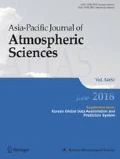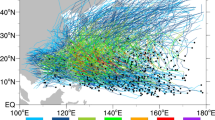Abstract
An objective tropical cyclone (TC) track analog verification technique has been developed to select all ensemble storm tracks predicted by the ECMWF 32-day ensemble that match the overall Joint Typhoon Warning Center (JTWC) post-season best-tracks. Ensemble storms within specified time and space differences of each JTWC track are first extracted as potential analogs, and four metrics of shortest distance, average distance, distance at formation time, and distance at ending time are calculated. An objective quality measure that assesses the overall track similarity between the potential analogs and each JTWC track is calculated in terms of membership functions for the four track metrics. Weighting factors multiplying these membership functions are adjusted to match with the quality measures for the ECMWF ensemble storm forecasts in a previous subjective evaluation. Objective verifications for the 2009 and 2010 seasons have been summarized in terms of Hits, Misses, False Alarms, and Correct Negatives that no TC would be present in the western North Pacific. The most important result is that the ECMWF ensemble was able to predict nearly all of the TCs in both seasons with only a small number of Misses that generally were short-lived tropical depressions. Good performance in terms of Correct Negatives was achieved during the 2010 season. False alarms are defined to be all ensemble storms that could not be matched any JTWC tracks within the specified thresholds. Evaluations of the characteristics of the false alarms indicate seasonal and geographic biases and that about 50% of the false alarm in the Week 1 forecasts originate from the initial the initial conditions in the model. A minimum of false alarms created in Week 2 forecasts is attributed to the decrease in horizontal resolution in the model that occurs at day 10. A steady and nearly uniform increase in false alarms in the Week 3 and Week 4 forecasts may be attributed to net convective heating in response to persistent environmental forcing in the tropics.
Similar content being viewed by others
References
Belanger, J. I., J. A. Curry, and P. J. Webster, 2010: Predictability of North Atlantic tropical cyclones on intraseasonal timescales. Mon. Wea. Rev., 138, 4393–4401.
____, P. J. Webster, J. A. Curry, and M. T. Jelinek, 2012: Extended prediction of North Indian Ocean tropical cyclones. Wea. Forecasting, 27, 757–769.
Chan, J. C. L., 2000: Tropical cyclone activity over the western North Pacific associated with El Niño and La Niña events. J. Climate, 13, 2960–2972.
Dupont, T., M. Plu, P. Caroff, and G. Faure, 2011: Verification of ensemble-based uncertainty circles around tropical cyclone track forecasts. Wea. Forecasting, 26, 664–676.
Elsberry, R. L., 2010: Critical time requirements for operational use of deterministic and ensemble tropical cyclone track forecasts. Asia-Pacific J. Atmos. Sci., 46, 217–220.
____, J. R. Hughes, and M.A. Boothe, 2008: Weighted position and motion vector consensus of tropical cyclone track prediction in the western North Pacific. Mon. Wea. Rev., 136, 2478–2487.
____, and A. Chollet, 2010: Role of mesoscale convective rings and mesoscale convective blowouts in tropical cyclone formations during TCS-08 experiment. Presentation, 29th Conference Hurricanes and Tropical Meteorology, Amer. Meteor. Soc., Tucson AZ, 10–14 May.
____, M. S. Jordan, and F. Vitart, 2010: Predictability of tropical cyclone events on intraseasonal timescales with the ECMWF monthly forecast model. Asia-Pacific J. Atmos. Sci., 46, 135–153.
____, M. S. Jordan, and F. Vitart, 2011: Evaluation of the ECMWF 32-day ensemble predictions during 2009 season of western North Pacific tropical cyclone events on intraseasonal timescales. Asia-Pacific J. Atmos. Sci., 47, 305–318.
Majumdar, S. J., and P. M. Finocchio, 2010: On the ability of global ensemble prediction systems to predict tropical cyclone track probabilities. Wea. Forecasting, 25, 659–680.
Mueller, C., T. Saxen, R. Roberts, J. Wilson, T. Betancourt, S. Dettling, N. Oien, and J. Yee, 2003: NCAR Auto-Nowcast system. Wea. Forecasting, 18, 545–561.
Tsai, H.-C., K.-C. Lu, R. L. Elsberry, Mong-Ming Lu, and Chung-Hsiung Sui, 2011: Tropical cyclone-like vortices detection in the NCEP 16-Day ensemble system over the western North Pacific in 2008: Application and forecast evaluation. Wea. Forecasting, 26, 77–93.
____, and R. L. Elsberry, 2013: Opportunities and challenges for extended-range predictions of tropical cyclone impacts on hydrological predictions. J. Hydrol. (in press).
Van der Grijin, G., J.-E. Paulsen, F. Lalaurette, and M. Leutbecher, 2005: Early medium-range forecasts of tropical cyclones. ECMWF Newsletter, 102, 7–14.
Vitart, F., J. L. Anderson, and W.F. Stern, 1997: Simulation of interannual variability of tropical storm frequency in an ensemble of GCM integrations. J. Climate, 10, 745–760.
____, T. Stockdale, and L. Ferranti, 2007: Seasonal forecasting of tropical cyclone frequency. ECMWF Newsletter, 112, 16–22.
____, 2009: Impact of the Madden-Julian Oscillation on tropical storms and risk of landfall in the ECMWF forecast system. Geophys. Res. Lett., 36, L15802, doi10.1029/2009GL035089.
____, A. Leroy, and M. C. Wheeler, 2010: A comparison of dynamical and statistical predictions of weekly tropical cyclone activity in the Southern Hemisphere. Mon. Wea. Rev., 138, 3671–3682.
____, F. Prates, A. Bonet, and C. Sahin, 2012: New tropical cyclone products on the web. ECMWF Newsletter, 130, 17–23.
Wang, B., and J. C. L. Chan, 2002: How ENSO regulates tropical storm activity over the western North Pacific. J. Climate, 15, 1643–1658.
Author information
Authors and Affiliations
Corresponding author
Rights and permissions
About this article
Cite this article
Tsai, HC., Elsberry, R.L., Jordan, M.S. et al. Objective verifications and false alarm analyses of western North Pacific tropical cyclone event forecasts by the ECMWF 32-day ensemble. Asia-Pacific J Atmos Sci 49, 409–420 (2013). https://doi.org/10.1007/s13143-013-0038-6
Received:
Revised:
Accepted:
Published:
Issue Date:
DOI: https://doi.org/10.1007/s13143-013-0038-6



